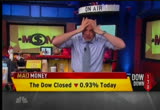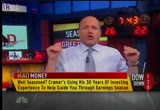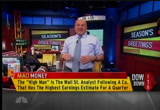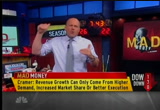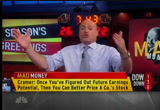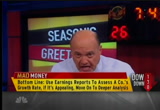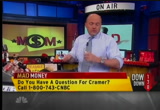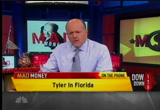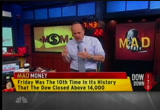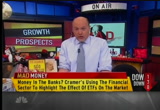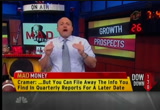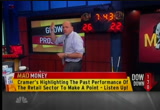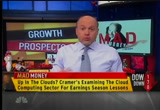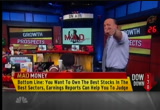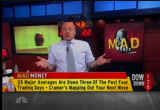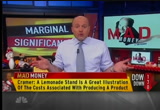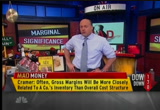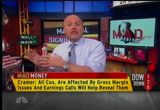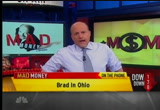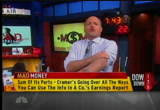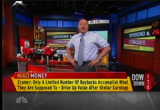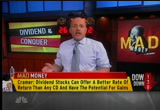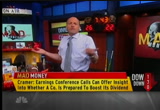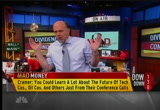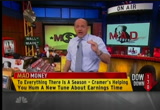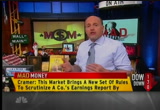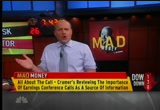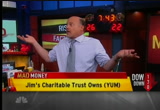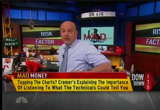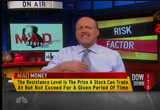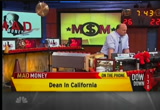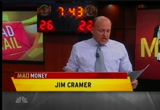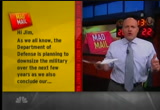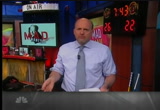tv Mad Money NBC February 5, 2013 3:00am-4:00am EST
3:00 am
>> i don't want to think about cooking. >> and then we're going to while that's sort of cooking, we're going to let the red onion cook down a little bit. >> uh-huh. >> we're going to mash some >> i'm jim cramer, and welcome to my world. you need to get in the game. firms are going to go out of business and he's nuts! they're nuts! they know nothing! i always like to say there's a bull market somewhere. "mad money," you can't afford to miss it. hey, i'm cramer. welcome to "mad money," welcome to cramerica. other people want to make friends, i'm just trying to make a little money. my job is not just to entertain you, but i'm doing teaching tonight. call me at 1-800-743-cnbc. earnings season. earnings season, i dread earnings season. why? because it is overwhelming with so many companies reporting at once and so much data being thrown at you. because it's hard to keep track of the expectations and really know what is better than expected. what the whisper, the real benchmark that must be beaten is.
3:01 am
uh-uh. i had a really bad back and i can't stand carrying all those printed out versions of the conference calls as i schlepped from downtown manhattan where i do "squawk on the street" and work at the street to my studio where i do "mad money" in englewood cliffs. tonight i want to do something different. i've got to help you this earnings season. i wanted to offer you a new way to use earnings season, to put it in perspective, because most of you watching the show are not these day traders that i think really hijack a lot of the thinking. you're not trying to game a given quarter. it's become so difficult to predict, and often the initial moves aren't even accurate because of the press coverage or because something nasty occurred in the overall market because of europe or something involved with the election. in other words, other than those who are shorting or going long stocks ahead of the quarter, these earnings reports need a context to make you money. they can't be relied upon anymore because they aren't as predictive of future behavior as they once were. they are a piece of the puzzle, a part of the mosaic, but they
3:02 am
are only one of many important parts of what predicts where a stock will go over the intermediate term. that tends to be the focus that i teach on the show. and it is a teaching show because i want you to know the metrics i'm using to pick stocks i talk about and recommend here, and with my charitable trust, which you can follow along at actionalertsplus.com. i also want to teach you how to listen to these conference calls and read them in the transcripts, give you my opinion what matters and how i let them factor into my thinking of picking stocks. i'm hoping this show will once and for all, because this is what i see at jim cramer on twitter constantly, tell you how to use earnings season as a way to evaluate your portfolio. figure out what you need to trim, what you need more of. let it help your stock selection, hone your way of thinking. not mine, but yours. earnings season is incredibly important for what it tells you about a host of issues, four times a year. big report cards. not just the trajectory of the estimates. we're going to flesh all that out. so tired of the estimates a penny or two. that's not making anybody any
3:03 am
money. we can't dismiss earnings season. that would be totally wrong. we've got to put it in context. here's how i use these reports we constantly refer to. first, i assess them for the predictive value for the year. to do that, i try to discern where analysts go with their estimates after the companies report. do they raise them, lower them, keep them the same? let's say apple has used a report that's better than not only the posted numbers that you can find on a lot of websites but also beats what's known as the high man, the analyst who is the most aggressively high estimates on the street. that beat will always cause a raising of numbers for the rest of the year by everyone. or if it is the end of the year for the numbers in the year after it. i use that increase in earnings per share, the ones they bump it, okay, to figure out several things. first, i try to figure out the increases from real business, actual sales. do they do better? and not just accounting changes and share count changes. to do what i like to do, i look
3:04 am
more at the revenues than at the actual earnings themselves. the company can't change the sales line except by increasing demand, producing more, gaining more customers, either at the expense of others or through better salesmanship, execution, and customer acquisitions. they're doing a better job. they're working harder. they're working it better. but a company can easily change the earnings by buying back a ton of stock. not the sales line, but the earnings. simply changes the denominator, the number of shares while keeping the numerator and the profits static. revenue growth in the quarter, particularly the holy grail accelerated revenue growth, argh, both quarter to quarter and year-over-year drive my thinking. they allow me to figure out future revenue and earnings growth. that allows me to figure out what to pay for the stock in the future. lots of people examine the price to earnings multiple to make a determination of the stock's worth and what i call the p/e vacuum. they say a stock that sells 20
3:05 am
or 30 times earnings, when the average stock sells at 11 times the s&p, they say that's too expensive, it sells more than the average stock. lazy thinking. what you need to do is figure out what that growth rate is using the revenue and earnings prism i just laid out for you. figure out how fast the company's growing, both linked quarter and the current one and then the year-over-year quarter and then calculate that trajectory versus the growth rate. here, here, let's put it simple. if a company's growing at 20% and the price to earnings multiple, stock price divided by the earnings per share, is 20 or less, hey, you know what? you probably have a big bargain on your hands. again, fundament of the show. the price to earnings to growth ratio, a much more important ratio because it puts the multiple into context you can use versus other stocks. we're always comparing other stocks on the show. as a rule of thumb, i'm willing to pay a price to earnings multiple that may be up to twice the growth rate, especially if there are very few companies growing that fast, meaning there is a scarcity value of fast-growing companies.
3:06 am
higher than that, paying 70 times earnings for a company growing 40% begins to get me nervous. even at 40% growth is hard to come by. that's nosebleed territory and there are too many things that can go wrong with the stock when that happens. the converse is true too. when i see a stock that sells for less than one times the earnings per share growth, i begin to salivate because unless there are other factors going against it, the factors that we covered in the rest of the special show, i'm drawn enough to that stock that i have to find other reasons not to buy it. so the bottom line, i use the actual earnings per share reports to figure out the growth rates of the stock and if the growth rate is high and the price to earnings multiple based on the future projections is equal to or less than twice the growth rate i'm interested enough to proceed with the rest of the work that this special show will detail. i need to go to brad in south carolina. brad. >> hey, jim, i want to give you a big ron paul boo-yah to ya. >> wow, okay, that's aggressive. i'll take that.
3:07 am
go ahead. >> caller: i'm just wondering how to best prepare for this earnings season in terms of online research resources. give me the inside scoop as you stay on top of all of the market updates. >> okay. what i like to do -- first of all, i watch cnbc. i'm not kidding, cnbc covers earnings season better than anyone. i go to the websites. the websites are now so, so good that literally they will have the analyst reports, they will have a lot of projections and then i look at the news stories just to get a sense about what the consensus is, and then i look at the analyst reports the day after and all that has to be done if you're going to really sink your teeth in and feel very confident. start with the website of the stock. let's go to daryl in california. >> caller: yes, boo-yah, jim cramer. >> boo-yah. >> caller: i have a question. what is meant by a reverse split stock? >> okay. that means if there's a million shares, you know, let's say they
3:08 am
do three to one, they make it to 300,000 shares. what it typically done, citigroup did one of these. what it does if you have like, you know, 300 billion shares, you divide it by three, you get 100 billion, it does raise the price, but it's illusory. you just have fewer shares. tyler in florida, please, tyler. >> caller: hey, jim, south florida boo-yah. >> oh, i'll take that. i need to go there now. always. what's up? >> caller: hey, sunshine, actually no, it's not, overcast. hey, quick question for you, when you talk about the economy, you know, really booting off again, it seems like you talk about it in terms of consuming and not producing, and i'm thinking, you know, from the way i think about it, you need something to be produced before it's consumed. i'm wondering why in terms of a growing economy you talk about consumption instead of production. that's what it seems like to me. >> well, i do because in order to be able to raise price, you need demand. if there's a shortage of supply, sure, that can mean something, but not if there's no demand. right.
3:09 am
if you have shortage of supply of some product that nobody likes, you can't raise price. it doesn't mean anything. and that's why we focus on demand on the show. a company has got to earn its stars before you buy it. use the e.p.s. to figure out a company's growth rate and then take it from there. "mad money" will be right back. don't miss a second of "mad money." follow @jimcramer on twitter. have a question? tweet cramer #madtweets. send jim an e-mail to madmoney@cnbc.com or give us a call at 1-800-743-cnbc. miss something? head to madmoney.cnbc.com. a lot of you may have heard about probiotics but may not realize what they can do for your health. we know what it takes to look good on the outside but with 70% of our immune system located in our gut, the core of our health
3:10 am
is truly on the inside. that's why i take new trubiotics. it's a daily probiotic that helps in two ways. one helps support digestive health, the other immune health. stay true to your health. new trubiotics. from the makers of one-a-day. [ sneezes ] [ sniffles ] [ female announcer ] for everything your face has to face. face it with puffs facial tissues. puffs has air-fluffed pillows for 40% more cushiony thickness. face every day with puffs softness. all right that's a fifth-floor probleok..ry day not in my house! ha ha ha! ha ha ha! no no no! not today! ha ha ha! ha ha ha! jimmy how happy are folks who save hundreds of dollars switching to geico? happier than dikembe mutumbo blocking a shot. get happy. get geico.
3:11 am
fifteen minutes could save you fifteen percent or more. i played a round of golf.id in the last five hours? then i read a book while teaching myself how to play guitar; ran ten miles while knitting myself a sweater; jumped out of a plane. finally, i became a ping pong master while recording my debut album. how you ask? with 5-hour energy. i get hours of energy now -- no crash later. wait to see the next five hours.
3:12 am
welcome back to "mad money" special earnings season companion show. how not to be overwhelmed by earnings reports and to put them into perspective so you can profit from them in an informed and confident way to make money at home. we just went over how i like to use the earnings reports themselves to figure out the growth rate. late after the stock price to figure out if it's too expensive and too cheap against the sector and the rest of the market. the next way i use the earnings report, though, is equally as important. in some ways because of what i call the etf-ization of the market, even more important than the growth rate versus the price of the stock and its earnings per share.
3:13 am
i measure the stock's earnings growth and quality of earnings growth against the cohort and then i figure out whether, here it is, the whole cohort is worth owning or forgetting about. wow. that's right. for most of my more than three decades of investing, i've accepted the fact that the sector is important when you're picking a stock. right, it matters? historically a stock sector has counted maybe as much as 50% of the stock's performance. but you know what? now because so many people trade through etfs and because they have become so popular as ways for both individuals and more importantly hedge funds to make decisions about stocks, take quick action, the sector has superceded earnings at times. and often it's made earnings all but an afterthought for individual companies. take, for example, the way banks traded in the last few years. it didn't matter for the most part whether s bank had strong earnings or weak earnings, if the bank was in the xlf that encompasses so many banks and people didn't want to own the xlf, didn't matter how well a bank did. a bank like wells fargo, u.s. bancorp, domestic banks with little exposure to weakened europe and very strong managements.
3:14 am
citigroup, jpmorgan, morgan stanley with tremendous exposure to the continent. that's why at times i've had to dismiss the earnings per share gains entirely at the moment if the cohort was radically out of favor. but i never just forgot them. instead, i tried to figure out which ones can at times break the tug of the sector, the gravitational pull and which ones can really shine because if the sector falls back into favor, i've got to be ready. for example, ever since the market's gigantic bottom in 2009, we've seen many sectors of retail and individual stocks within those sectors outperform. i like to listen to the earnings calls of all the retailers. at given times, i'm rapt by the groups doing the best. by far the top performers during this period have been the discount stores, notably dollar general and dollar tree. when i see the markets money go to retail, i go back to my earnings report memory and reach for these two.
3:15 am
because i know they have the most earnings momentum. i only know that because i keep listening to the calls. even though the group may have been out of favor of late. when everyone piles into the retail etf, which i use the rth, i am in there with the ones with the best momentum. ross, tjx and bed, bath and beyond, during these sectors, you know, when they grab a sector because they have the most inexpensive earnings momentum. there's another strategy for more sophisticated investors that i want to let you in on too. when i know which are the best of the best in terms of earnings because i focus on the calls and a huge amount of money was poured into a given sector, i might hedge my bets, sell the etf and buy the best performers in the etf according to my earnings per share work. that way if the move takes a turn for the worse, we get a large macro number that hurts our market. one of those government numbers or we get some weakness out of europe, i can lose less than the people just playing the earnings momentum game because i own the best and i'm short the rest.
3:16 am
sector analysis is particularly important in technology, because people confuse this gigantic group of stocks which comprises more than 50% of the s&p 500 constantly. tech is actually an agglomeration of a whole group of sectors. semiconductors, disk drive, personal computers, large scale enterprise hardware makers, cell phones, tech, telecommunications tech, assemblers. each has a separate growth rate and i like to look at the growth rates of the companies i follow versus the individual slices of the sectors. because the sector growth rate doesn't work even though people keep trying to use it. cloud stocks are highly valued, meaning their price to earnings to growth rates are extreme. that means no room for error or hair as we call it, meaning something's wrong. salesforce reported a magnificent quarter. but the guidance for the billings was lighter than i was hoping. the stock immediately got pancaked and stayed ugly for a long time. why? because it underperformed its portion of the technology sector
3:17 am
even as its growth rate would have been outstanding for a personal computer related stock or a disk drive, semiconductor, or cell phone company. these days knowing what the sector is isn't enough. you need to know the subsector. you need to know how your company stacks up against the growth rate of that subsector and have a good handle on whether that larger sector is in favor or if it isn't. nothing's worse than owning a bad stock as defined by weak earnings in a bad sector neighborhood. nothing's better than owning a good stock in a great neighborhood. but if you do not measure against the sector's growth and do not determine first whether the sector is in favor versus out of favor, then the earnings report better than expected or not, it won't mean a thing. when we return, i'm going to give you several more ways to use these earnings reports in the context of stock picking. not just trading. which i have come to see as pretty much of a zero sum game. >> stay with cramer. jim cramer, looking out for
3:18 am
you. >> thank you, sir, for helping us average joes on the road to financial freedom. >> thanks for all you do for small investors. >> i want to thank you for sharing your knowledge with the every man. >> i love doing it for you, any time anyone says that i say thank you, it's great. >> anywhere, any time, any place. answering the call of cramerica weeknights 6:00 and 11:00 eastern on cnbc. keep up with cramer all day long, follow @jimcramer on twitter and tweet your questions #madtweets. every year we pick a new city to explore. but thanks to hotwire, this year we got to take an extra trip. because they get us ridiculously low prices on really nice hotels and car rentals. so we hit boston in the spring-- even caught a game. and with the money we saved, we took a trip to san francisco. you see, hotwire checks the competitions' rates every day so they can guarantee their low prices. so, where to next?
3:19 am
how about there? ♪ h-o-t-w-i-r-e... ♪ hotwire.com diarrhea, gas, bloating? yes! one phillips' colon health probiotic cap each day helps defend against these digestive issues... with three strains of good bacteria. [ phillips' lady ] live the regular life. phillips'. [ phillips' lady ] live the regular life. did you just turn your ringer off so no one would interrupt and.us?one. oh no, i... just used my geico app to get a tow truck. it's gonna be 30 minutes. oh, so that means that we won't be stuck up here, for hours, with nothing to do. oh i get it, you wanna pass the time, huh.
3:20 am
3:21 am
tonight we are talking not about who just reported better than expected quarter getting all excited about that. something we get caught up in during every earnings season. how to use these reports to put together the ideal portfolio for the long-term, not for tomorrow's trade. we've established the importance of those reports for what they tell us about the growth of a stock and where it fits inside a sector as well as the sector's gravitational pull that could overwhelm even the best earnings reports. hey, best house, bad neighborhood, neighborhood wins. now we've got to dig further than the headlines to discern what else on the conference call or in reaction to the call that can help us make some money. we don't stop with just a call. what else is important to listen to on these? the wall street analysts would tell you the most important concept, most important predictor of future earnings is the gross margin, what's left
3:22 am
after the cost of sales are subtracted. a lemonade stand, the costs of goods are simple to understand. yeah, yeah, some sugar. you figure out how much those cost, subtract it from what you charge, you've got the gross margin. there are plenty of other issues that go into it. the time it takes to make up the sign, number of people who sat behind the stand, the labor equipment of the time if you paid someone else besides yourself to man the stand. same goes for publicly traded businesses. whether they are going up or down. that's the inflation/deflation component, how much the labor costs, very important in a rising salary environment. how much leverage there is, meaning, if you have all of the laboring costs accounted for, how much business can you do? all right, the one i like to think of, it's not a lemonade stand, but it's pretty well chipotle. they have labor and they have food and customers. the more customers they can serve per hour, the more leverage they have.
3:23 am
the keys to the gross margin at chipotle are the cost of the guac, beef, chicken, tortillas, the cost of the labor and most importantly the number of customers they can push through in a given day. of course there are dozens of other inputs advertised in leases and the stores need to have as little turnover as possible because the cost of training new employees is tremendous. it's a huge obstacle to making a lot of money. that's something the former ceo of costco made clear to us. he was legendary for paying his employees the most and treating them with the best of benefits because it's so important to keep them happy, so the firm doesn't constantly have to train new people. new people are not known to the regular customers, who like to see the same old hopefully smiling faces. new people cost too much money. same goes for chipotle, where the most talented people are quickly given promotions and opportunities to run more stores. mcdonald's similarly often praised for its gross margin improvements. by the way, because it has the best market muscle, low-cost goods and good leases but also because it has the technology to
3:24 am
innovative on a quick scale. one that does not befuddle the less skilled employees. gross margin comes into play in every industry i follow. always in different ways. often the key to the gross margin has less to do with the cost structure of the company and more to do with the inventory conditions of an industry or a given company. now we're talking tech. semiconductor companies, for example, often produce flat out, making as many chips as they can 24/7. at times end demand wanes and the supply chain gets overwhelmed. okay, it gets glutted. in order to move more inventory, the chip companies often have to cut price, which then lowers their gross margins and often makes their earnings too volatile to predict and therefore too volatile to give them a high price to earnings multiple. that's when you see pre-announcements. we like companies with consistent growth and we pay higher multiples for them and we don't like that inconsistent growth that tech gives us and we pay lower multiples for them. no one could handle all that inventory glut that keeps happening once or twice a year.
3:25 am
same goes for companies like steel and aluminum. at times producing too much, at times the products from other countries notably china cause a glut in the system. prices get slashed, future earnings per share get crushed. i listen closely on these commodity calls to get a sense of whether inventory is building anywhere in the system. because if it is, i can tell that the gross margins are coming down and i've got to get you out of those stocks quicker than i do aluminum, steel, copper, i've got to work faster. don't you believe for one moment it's just the commodity producers that are affected by these gross margins. i listen to every single major pharmaceutical call for you. i hear about generic competition and what that may mean for future earnings. drugs coming off patent, it'll plummet in price is one that scares me. and i tell you to get out because i think it's going to trade at a low multiple to future earnings even if it traded as a high one in the past. until the stock discounts that, i've got to keep you out of it. very few drug companies are immune from this gross margin compression. i steer clear of them as best as i can until everybody knows about the patent cliff and then
3:26 am
i can go back. finally there are gross margins of the oil service companies. these are the hardest. they're difficult because you often have to figure out several numbers for the gross margins, how much it costs to drill to get in and out of the ground, to ship it to refine it. many companies in the industry have tried to break themselves up to make it easier for guys like me to figure out their gross margins. i care chiefly about finding costs and about end market prices. that's why the natural gas companies, for example, traded at discount to the pure oil companies because the end market price of natural gas has been so low for so long and the end market price of crude has been so high for so long. that's what draws me toward a company like an eog or continental, both with cheap finding costs for oil and they've got expensive prices when they get it out of the ground. the bottom line, the key component after figuring out the earnings per share trajectory and its growth related to the cohort is to figure out the future gross margins, something that is uniquely calculated only
3:27 am
by listening to the conference calls. can't get that in the headlines or any of the press reports. if you don't know the direction of the gross margins, you won't know the direction your stocks are about to take in your portfolio. it is an integral part of the homework. and if you don't calculate yourself, you've got to get it from somebody. be sure to read from the analysts who do. let's go to brad in ohio, please. brad? >> caller: boo-yah from gerard, ohio. >> got to get there. i haven't been there yet. i'll get there. i promise myself. >> caller: thanks for taking my call. >> sure. >> caller: my question is, as an investor interested in specialty retail, i understand that the fourth quarter is definitely a quarter with the most significant earnings. >> right. >> caller: how should one evaluate these companies first quarter earnings? >> you know what? i used to go back to the rules of my hedge fund. i frankly don't care about the first quarter for retail. the fourth quarter i care about, first quarter doesn't move the needle. really only have valentine's day during that quarter. i know that because my dad sells gift wrap.
3:28 am
it's one of those things where you realize what the seasons are and valentine's day doesn't move the needle like christmas. i like the holiday season, like hanukkah. i'll make my judgments from retail on the fourth quarter. i don't make any on the first quarter. it's all that matters, i wait to hear those quarters and then i make my judgment for what the next year's going to bring. mike in illinois. mike? >> caller: cramer, this is mike in the windy city giving you a chicago bears b-b-boo-yah. >> what's up? >> caller: if i short a stock, how long do i have to cover that short? >> forever. forever. that's one of the great things about shorting. stay short for as long as you want. if the stock goes up, they may ask you to put more money up, though, and that's where people get squeezed. okay. you've got to dig deep if you want deep profits. gross margins will guide you in figuring out the direction of a stock. and some things you'll only find on the conference calls, not the headlines. gross margins, that's on the call. stay with cramer.
3:29 am
we know a place where tossing and turning have given way to sleeping. where sleepless nights yield to restful sleep. and lunesta®(eszopiclone) can help you get there. like it has for so many people before. when taking lunesta, don't drive or operate machinery until you feel fully awake. walking, eating, driving, or engaging in other activities while asleep, without remembering it the next day, have been reported. lunesta should not be taken together with alcohol. abnormal behaviors may include aggressiveness, agitation, hallucinations, or confusion. in depressed patients, worsening of depression, including risk of suicide, may occur. alcohol may increase these risks. allergic reactions such as tongue or throat swelling occur rarely and may be fatal. side effects may include unpleasant taste, headache, dizziness, and morning drowsiness. ask your doctor if lunesta is right for you. then find out how to get lunesta for as low as fifteen dollars at lunesta.com. there's a land of restful sleep. we can help you go there on the wings of lunesta.
3:30 am
with just a few ingredients. simple, wholesome goodness. kellogg's. start simple, start right. this is so so soft. hey hun, remember you only need a few sheets. hmph! [ female announcer ] charmin ultra soft is so soft you'll have to remind your family they can use less. ♪ charmin ultra soft is made with extra cushions that are soft and more absorbent. plus you can use four times less. hope you saved some for me. mhmm! you and the kids. we all go. why not enjoy the go with charmin ultra soft.
3:32 am
you're hearing tonight for the first time not how to figure out what's a better or worse expected earnings report to do a good trade. seems to be a dominant way of thinking. how to put these reports to work for you. select the best stocks and prune those that need to go. talking longer term perspective. we figured out how to compute the growth rate of a company. something that @jimcramer on twitter, i keep getting that question, now it's answered. we've explained the importance of sector analysis as part of the earnings report. and we've learned how to focus on gross margins, something that can only come out of the conference call. now we must address two more pieces of the earnings puzzle and these are really important. dividend growth and home run potential. from pretty much the times since i first bought stocks in the late 1980s until fairly recently, dividends were an afterthought. ever since i had my hedge fund. companies became enamored of buybacks as a way to return money to existing shareholders. to me it's oxymoronic. you're returning money to
3:33 am
departing shareholders and making it easier for them to exit. the only real winners with shareholder buybacks except in extreme cases in auto zone work, novellas where the executives who get paid for hitting certain targets. they do that by shrinking the float through buying back enough stock to make it so when the share count is divided into the earnings per share, well, it beats the compensation benchmark that they were supposed to hit. only a very handful of buybacks do what they're really supposed to do. that is make it so there are far fewer shares out there, something that can drive a stock higher if the earnings are excellent. but the buyback that actually accomplishes that goal, man, i've got to tell you, count them on one hand. most buybacks turn out to be a huge waste of money as companies will spend a gigantic amount of cash buying their stock when prices may have been appreciably higher. they only know about their own business, which is fine, they should stop trying to time the market. what should they be doing? what are the good companies doing now? they're offering more and more bountiful dividends, something that's a much better sign than
3:34 am
management believes in a future than a buyback. buybacks are indefinite. dividends are an out loud declaration of long-term confidence. now that low rates seem to be upon us for some time, courtesy of fed, anxious to throw gasoline on the smoldering economic embers, dividends can provide a rate of return that you keep trying to make money with, can't. of course stocks present more risk than cds. they can go down. but they can also go higher. and that's often the case with companies that continue to boost their dividends year after year. and if you reinvest those dividends, you can augment your return to the point where you are far exceeding a return on bonds. dividends are so important they've been responsible for almost 40% of the s&p 500's return the last ten years. they are also the main reason why the dow jones average with the above average dividend yield far outperformed the s&p 500 in 2011, 5.5% return for capital appreciation. how about making a total 8% if you reinvested the average dividend and the only thing you should be thinking of when you talk about benchmarks.
3:35 am
cash in your pocket, safety net during the bad times and a trampoline in the good. what do the earnings have to do with the dividend component that we so often seek on "mad money"? simple. we listen for calls that tip management's hand on the dividend, that tell us there's enough excess cash available to boost that dividend, perhaps several times in a short period of time. hey, that's what we heard from general electric in 2011. it signaled -- it was on every conference call they mentioned it. conversely, if a company signaled a desire to buy back more stock and the buy back's ineffective reducing the share count, you've got to look at the shares the year before, the year before, the year before. it's a less proven innocent. they're containing the damage from the shares and options offered to management. a lot of tech companies do what i've regarded as disgraceful. i know what i see. these days if a management doesn't indicate it might boost the dividend on the earnings call, count me out unless the company has such ferocious
3:36 am
earnings power, a la apple, that i'm willing to overlook such indiscretion. we also need to listen for something breakout, something new on a conference call. something if the company's going to do differently or announce soon that can serve as an upcoming catalyst. i scrutinize calls for not what has happened, but something that will happen. if it sounds like it can propel the stock in the future, i'm anxious to buy it. and if there's a selloff, a company didn't please the momentum funds of the stock, i got my opportunity. all right, what are the examples i look for? pharmaceutical companies, they often telegraph what might be going into stage three, okay. meaning what drugs might be near final approval. they often tell you about expanded usage on their labels for drugs. allergan has told you more about the future on its call than just about any other, and it has been a terrific buy. every time it sells off after
3:37 am
earnings because of this upcoming catalyst, it's constantly doing it. by the way, celgene, same thing. they give you a call that tells you what's coming up. tech companies often tip their hands about upcoming product cycles, product initiations that can make a huge difference in future earnings. pipeline companies, key creators of dividend wealth. they tell you about upcoming expansions that could be additive to earnings. the exploration production companies almost always tell you what prospects they're looking for. and when you might hear some really good news on these calls. i always file those comments away and wait for the futures to go down. that's what happened last year with clr. gave you bountiful chance to get in before it raised guidance from new finds later in the year. we had gone out to the bakken, they were talking about the storms that kept their drilling down, that the storms ended, nobody cared. and then the stock took off when they told you that business is big and booming. the bottom line, we look for signals about the future on these calls, particularly about upcoming catalysts that will move the stocks later on, making
3:38 am
them solid buys on any short-term decline because it wasn't better than expected. we try to measure confidence about cash flow that could ultimately trigger rising dividends. the best source of wealth that stocks can give us. remember, dividends pay us to wait for things to get better. and there's no better way to find out about the prospects for increased dividends than to listen in on the earnings calls. stick with cramer. build your future -- >> happy boo-yah to ya. thank you for not just the money, jim, but what the money translates into. in my case, a college education for my son. >> boo-yah. >> boo-yah. "mad money" does work. >> "mad money," making you money for college. boo-yah, i love you. >> how many other shows have kids calling in saying boo-yah? >> one boo-yah at a time. "mad money" with jim cramer weeknights 6:00 and 11:00 p.m. eastern only on cnbc. i played a round of golf.id in the last five hours? then i read a book while teaching myself
3:39 am
how to play guitar; ran ten miles while knitting myself a sweater; jumped out of a plane. finally, i became a ping pong master while recording my debut album. how you ask? with 5-hour energy. i get hours of energy now -- no crash later. wait to see the next five hours. [ angry gibberish ] [ justin ] mulligan sir. mulligan. take a mulligan. i took something for my sinuses, but i still have this cough. [ male announcer ] truth is, a lot of sinus products don't treat cough. they don't? [ male announcer ] nope, but alka seltzer plus severe sinus does it treats your worst sinus symptoms, plus that annoying cough. [ angry gibberish ] [ fake coughs ] sorry that was my fault sir. [ male announcer ] alka seltzer plus severe sinus. [ breathes deeply ] ♪ oh, what a relief it is! [ male announcer ] try alka seltzer plus severe sinus day and night for complete relief from your worst sinus symptoms.
3:42 am
earnings season doesn't have to be a gatling gun of unfathomable numbers that exist only for hedge funds to attempt to profit. tonight we have showed you how to look for signs of what to do with your portfolio over the long run because the earnings reports and the subsequent conference calls, the crucial thing, look, here's the deal. they don't have to be shoot first, ask questions later experiences. actually, the opposite. conference calls are ask questions, ask questions, and then ask some more questions and only then maybe take action. we are asking specifically about what the growth of the earnings per share might be and how expensive that would make the
3:43 am
stock versus other stocks in the sector and maybe other stocks in the market as a whole usually regarded as being the s&p 500. we want questions answered about gross margins and whether they're going to be increasing, allowing us to judge if earnings estimates might be beaten in the future. we are looking for signs of dividends, these days the most important indicator of a company's health might be boosted and we are looking for catalysts that can propel a stock higher or after earnings season is over. data points, something big that's going to happen. that's important in a time when many stocks sell off in knee-jerk fashion, simply because some company didn't beat some estimate. there are two more items to be gleaned from these earnings reports and conference calls and they are new ones that i've had to add to the equation because of structural changes in the stock market over the last few years. the first is geopolitical risk. never really cared that much about it because america was king. geopolitical risk, linked exposure. not just to the rising price of oil, that can be jostled by the middle east, that's always been an issue. linked exposure to the sovereign
3:44 am
debt and banking debt issues of europe. we need to ask how much exposure there might be to chinese economy. for example, for most of 2011, it was impossible to own banks, right? they were perceived to have tremendous linkage to the troubled euro and its accoutrements. well, we got our heads handed to us. similarly owning tech, when tech is often to be considered heavily dependent upon europe. hey, come on as much as 20% to 25% of earnings for tech are derived from the continent. typically it's been deadly. we know this because the businesses don't dodge it on the conference calls. that's how you learn about it, people. the analysts won't let them get away with it. all you've got to do is listen to the q & a, and you're going to hear one out of every two or three questions about europe. asia, one out of two questions about china. that's too hard a steeplechase to go through. you want some preventive medicine, go through the previous calls, if the plurality
3:45 am
of questions are about europe, then you know you're going to be in for a bruising next time. that's what the analysts are focusing on, forcing the companies to talk about. as correlated with europe as many tech and bank stocks are, it's china that controls so so of the cyclicals. listen to the earnings calls of caterpillar, joy global, cummins, freeport mcmoran. peabody, vale, rio tinto. owning these stocks is like owning the great wall of china. you don't want to be in them when the great wall is crumbling. it's got to be a worry that i have seen downgrades of stocks like yum because it's got a huge chinese business through kfc and coach which has been expanding aggressively in china because of worries of a chinese slowdown. similarly, owning a steel company without paying attention to what the chinese are dumping on our markets is like taking your financial life into your own hands. how do you find out all these issues? companies as diverse as corning, 3m, ppg march to the asian drum.
3:46 am
you're not going to see it in the release. it's all in the pestering by the analysts. so it's pretty simple. listen to the call and don't hang up until you have heard the last questioners so you can tell how worried the analysts are about the markets that didn't move the needle a few years ago. one final piece of the earnings puzzle which is incredible. this is the earnings seasons that you have to weather something that i've never talked about before. okay. and we've got to do this before we're done for the night. one that's become obvious to anyone who watches this show regularly. i can't believe i have to do this. i'm a fundamentalist, but i'm going to say it. you have to know the chart of a stock ahead of the quarter. so often we have chartists on our off the chart segment who trace out what a pattern might be and where a stock could break down or break out if it hits a certain level. why is this so important? the chart is the expectation game in pictograph form. you have to recognize that the chart was the gauge of the expectation. you look at the chart, that tells you where the expectations are high.
3:47 am
often a chart rallies to particular level in advance of the quarter. typically to what we call a level of resistance. if the quarter isn't up to snuff, the stock can get hammered because of a chart failure. i don't want you to react to this kind of chartmanship. i want you to use it in your favor, which is why i save this chart take for last. you know what's an ideal stock to buy? one that has risings earnings per share growth, with rising gross margins, a potential for dividend increase and some good news on the horizon. that gives you the chance to get into the terrific price, one that you wouldn't otherwise be able to get because of the chart. why is this so important? because no journalist is ever going to attribute the decline in a stock to the chart. yet so many hedge funds are reacting entirely to that chart and taking silly action because of it. remember, i'm not a chartist, but i play like one when i have to. the bottom line, if the question and answer on the conference calls revolve around china,
3:48 am
europe, or asia, be prepared for a hammering this current quarter. and if a stock goes down big after a quarter you think should be going up later on, remember, that it might very well be the chart talking, the chart telling the tale and giving you a chance to get in cheaper than you might otherwise have a chance to do. now you are ready for the rest of earnings season. go get them and tell them cramer sent you. dean in california. dean? >> caller: hey, jim, how are you? hello from beautiful marin county. >> how can i help? >> caller: well, listen, i checked my stocks at the end of the day, and usually you'll see a little blurb on the news headlines says, for instance, a particular stock has a close or a buy imbalance at the end of the day and name the shares. what i want to know is what exactly do these close or buy balances mean? and do that vi have any implications? >> i think, no, i think it's more distractions, a lot of the buying may be etf related, some sort of market on close program.
3:49 am
it's confusing to people. we care about the fundamentals. maybe it affects the chart, maybe it doesn't. we care about the fundamentals, not the on balance volume. that would be a matter only if you were a big broker working 100,000 shareholders trying to get the best price at the end of the day. all right. it's all in the conference calls, everybody. a company's earnings release is much more than that. i need clues. clues that will signal where a company's going and i like to look at the charts. and, well, call me. call cramer. "mad money's" back after the break. when wall street hits turbulence, turn to a pilot with over 30 years experience. for over 75 years people have saved money with...ohhh... ...with geico... ohhh...sorry! director's voice: here we go. from the top. and action for over 75 years people have saved money with gecko so....
3:50 am
director's voice: cut it! ...what...what did i say? gecko? i said gecko? aw... for over 75 year...(laughs. but still trying to keep it contained) director's voice: keep it together. i'm good. i'm good. for over 75...(uncontrollable lahtuger). what are you doing there? stop making me laugh. vo: geico. saving people money for over seventy-five years. gecko: don't look at me. don't look at me. with just a few ingredients.
3:51 am
3:52 am
with over 25 years of experience in bull and bear markets, let coach cramer show you how to play to win. >> thank you to you and your staff for keeping us in the game. >> "mad money," weeknights on cnbc. now let's do some "mad mail" and "mad tweets" @jimcramer. you often encourage home gamers to do their homework. although i dvr every episode of "mad money," i don't recall you specifying exactly what you suggest should be involved in doing our homework. my version is mostly listening to every word on "mad money" and checking price movements and
3:53 am
charts. what else do you suggest we do? first of all, here's what you do with "mad money." i've wrote a whole book about how to do it. that's the starter. you hear a stock that you like, you decide you want to get to know it. you go to the website. you read about the last few quarters. i like to read the annual report, then i like to call what the analysts are saying. i like to see what could be in the pipe, i like to see how the dividend is. these are all part of the process long before i would think of pulling the trigger. and, by the way, i would like to think about what would make me sell it. if they miss certain things or did certain things, a lot of things for homework starts with the website. here's one from trace, no doubt the, well, the fantastic country singer. hi, jim, as we all know the department of defense is planning to downsize the military as we also conclude our business in afghanistan. do you believe that the large amount of military personnel and other support personnel will flood the job market and increase demand for goods? >> no, i don't think it'll move
3:54 am
the needle. and by the way, the army, navy marines, they don't move that fast. there could be a peace dividend. i don't think you should look at this issue in a way to be able to make money off of it, though. it's really not a needle-mover. as a matter of fact, it can be negative for a lot of the defense companies as we know and they've been under a cloud because of these cuts. here's one from danny in new york. hi, jim, i have heard you say when considering playing the downside of an equity you would short the stock rather than buy a put. please elaborate on your reasoning for this. danny, i'm so glad you sent me this because if i have created any misperception that i favor shorting stocks, it is completely out of character with all my books and what i used to do at my hedge fund or before i had my hedge fund when i was working for goldman sachs or trading for myself. i always do puts. i very rarely do shorts because as i write in "confessions of a street addict," i was a victim of some horrible short squeezes that lost me a ton of money. use puts, i don't care if
3:55 am
there's a premium. let's go to some tweets. here's one from bkelly019. covered calls allow me to print money out of large positions without having to sell. why do you hate them so much? okay. here's the answer. i've got to tell you something bkelly019, i hate cutting off my upside. that's what writing a call does. you can't make more money than when you write the call. not only that, let's say something goes wrong. so you sell the stock, you're really vulnerable to a takeover then because you're short the call. never ever ever cap your upside. that's always been my rule. never sell a put. that, i think, and i've seen it in '87, i saw that put people out of business, i saw it again in 2009. put people out of business. trust me on this. i have been around for just more than three decades, trust me on this. okay. here's one from jeff. boo-yah, jim, why does your strategy in looking at hospital stocks in general? how do you approach stocks like these at earnings season? all i care about is government pay. if the government's not in a
3:56 am
mood to be able to pay hospitals, if they're stingy toward hospitals, i don't want to touch them because there's not enough hospital mergers that can still be done without the government stepping in and saying, you know what? we've got to block that. so with hospitals, if the government's on your side, i could be a buyer. if the government's against you, stay away. but stick with cramer. keep up with cramer all day long. follow @jimcramer on twitter and tweet your questions #madtweets. [ male announcer ] playing in the nfl is tough. ♪ doing it with a cold, just not going to happen. ♪ vicks dayquil powerful non-drowsy 6-symptom cold & flu relief. ♪ no matter what city you're playing tomorrow. [ coughs ] [ male announcer ] you can't let a cold keep you up tonight. ♪ vicks nyquil powerful nighttime 6-symptom cold & flu relief. ♪
3:57 am
3:59 am
let's go to kentucky. >> boo-yah. >> a hillbilly boo-yah. >> caller: here's a big las vegas boo-yah. >> caller: a big staten island, hey now, forget about it boo-yah! >> caller: boston -- >> caller: michigan -- >> alaska -- >> boo-yahs come from all across america, let cramer help you channel yours. "mad money" with jim cramer weeknights.
72 Views
IN COLLECTIONS
WBAL (NBC) Television Archive
Television Archive  Television Archive News Search Service
Television Archive News Search Service 
Uploaded by TV Archive on

 Live Music Archive
Live Music Archive Librivox Free Audio
Librivox Free Audio Metropolitan Museum
Metropolitan Museum Cleveland Museum of Art
Cleveland Museum of Art Internet Arcade
Internet Arcade Console Living Room
Console Living Room Books to Borrow
Books to Borrow Open Library
Open Library TV News
TV News Understanding 9/11
Understanding 9/11
